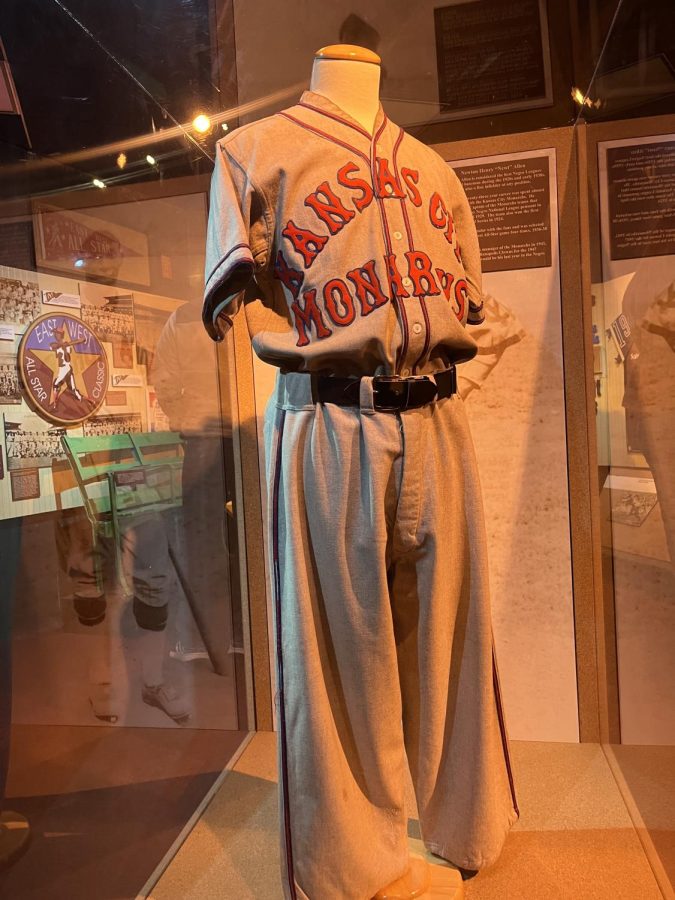Negro Leagues Baseball Museum: A time capsule of African-American heroes in baseball
February 25, 2023
The Negro Leagues Baseball Museum is a tribute to the pioneers who battled segregation to play America’s favorite pastime.
The exhibit, located in the heart of Kansas City’s historic 18th and Vine District, is dedicated to preserving the legacy of the Negro Leagues and its players, who were often overlooked and undervalued during their time.
The Negro Leagues were a series of African-American professional baseball teams that operated from the late 19th century to the mid-1960s. Despite facing discrimination and segregation, these teams provided a platform for talented Black players to showcase their skills and pursue their dreams of playing professional baseball.
The museum was founded by a group of dedicated individuals who were passionate about perpetuating this important part of American history. They collected artifacts, photographs and stories from former players, fans and historians. With that, they created exhibits that brought the struggles and triumphs of the Negro Leagues to life. Visitors to the museum are transported back in time, to a world where baseball was not just a game, but a symbol of hope and perseverance for African-Americans.
One of the museum’s most popular exhibits was a replica of a 1920s-era baseball field, complete with old-fashioned uniforms, gloves and bats. Guests could step onto the field and imagine what it was like for the players of the Negro Leagues to take the field in front of thousands of cheering fans. There was also a display of rare photographs, showcasing some of the greatest players in Negro League history, such as Satchel Paige, Josh Gibson and James Thomas “Cool Papa” Bell.
The museum is a wonderful experience for all. Many African Americans’ family members played in the Negro League, including the writer of this story. People travel from all across the country to visit the museum, and many have connections to the Negro Leagues and to Kansas City itself. Kansas City was known as a hotspot for many African Americans during when the leagues were established.
As the birthplace of the Negro National League in 1920, Kansas City played a crucial role in the development and success of the league.
For more than three decades, Kansas City was home to two of the most prominent teams in the league – the Kansas City Monarchs and the Kansas City Stars. The Monarchs, founded by J.L. Wilkinson in 1920, quickly became one of the most successful teams in the league, winning four league championships and one World Series title.
The team’s success was due in no small part to the talents of some of the greatest players in the history of baseball. Legends like Satchel Paige, Buck O’Neil and Jackie Robinson all played for the Monarchs at one time or another, solidifying the team’s reputation as a powerhouse in the Negro Leagues.
But the importance of Kansas City to the Negro Leagues went beyond just the success of its teams. The city was also a hub for black culture and entrepreneurship, providing a supportive community for players and team owners alike. This environment allowed for the creation and growth of the Negro Leagues, which offered black players an opportunity to play professional baseball at a time when segregation kept them out of the major leagues.
The contributions of Latin American players to the Negro Leagues are often overlooked in the history books, but a new exhibit at the museum is aiming to change that.
The exhibit, titled “Latinos in the Negro Leagues,” tells the story of the many Latino players who were a part of the Negro Leagues, despite facing their own unique challenges.
One of the most notable Latino players in the Negro Leagues was Martin Dihigo, a Cuban-born player who was known for his versatility on the field. Dihigo played multiple positions, including pitcher, outfielder and infielder, and was known for his impressive speed and power at the plate. He was inducted into the Baseball Hall of Fame in 1977.
Women also played a vital role in the Negro baseball leagues, breaking barriers and showcasing their talent on the diamond.
During the era of segregated baseball, Black women faced multiple obstacles in pursuing their passion for the sport. However, several all-Black female teams emerged in the 1930s and 1940s, such as the Kansas City Monarchs’ “Colored House of David” and the Memphis Red Sox’s “Soul Sisters.”
The players on these teams faced racism, sexism and poor working conditions. They often had to travel long distances in cramped buses, sleep in segregated accommodations and endure verbal abuse from spectators and opponents.
Toni Stone, who played for the Indianapolis Clowns in 1953, was the first woman to play in the Negro Leagues. She was followed by players like Mamie “Peanut” Johnson and Connie Morgan, who also played for the Clowns in the 1950s.
There is a lot to learn about the museum. Visitors might also be able to catch Negro League President Bob Kendrick walking the halls. He’s more than willing to stop and chat with people about the league.
The museum is one shop stop for everything Negro League related. It’s free to attend during the month of February.
mcdanieljc@umsystem.edu









